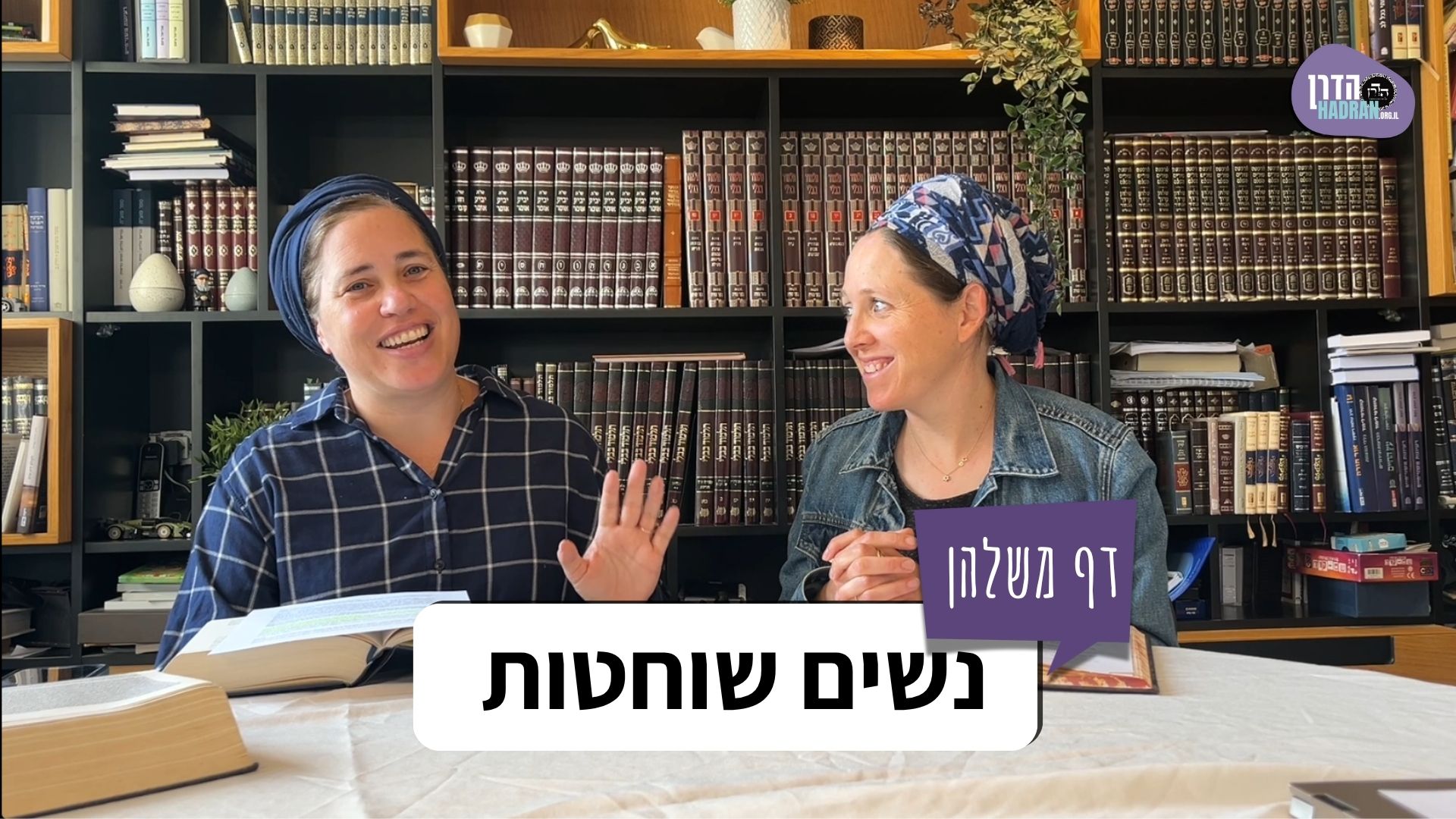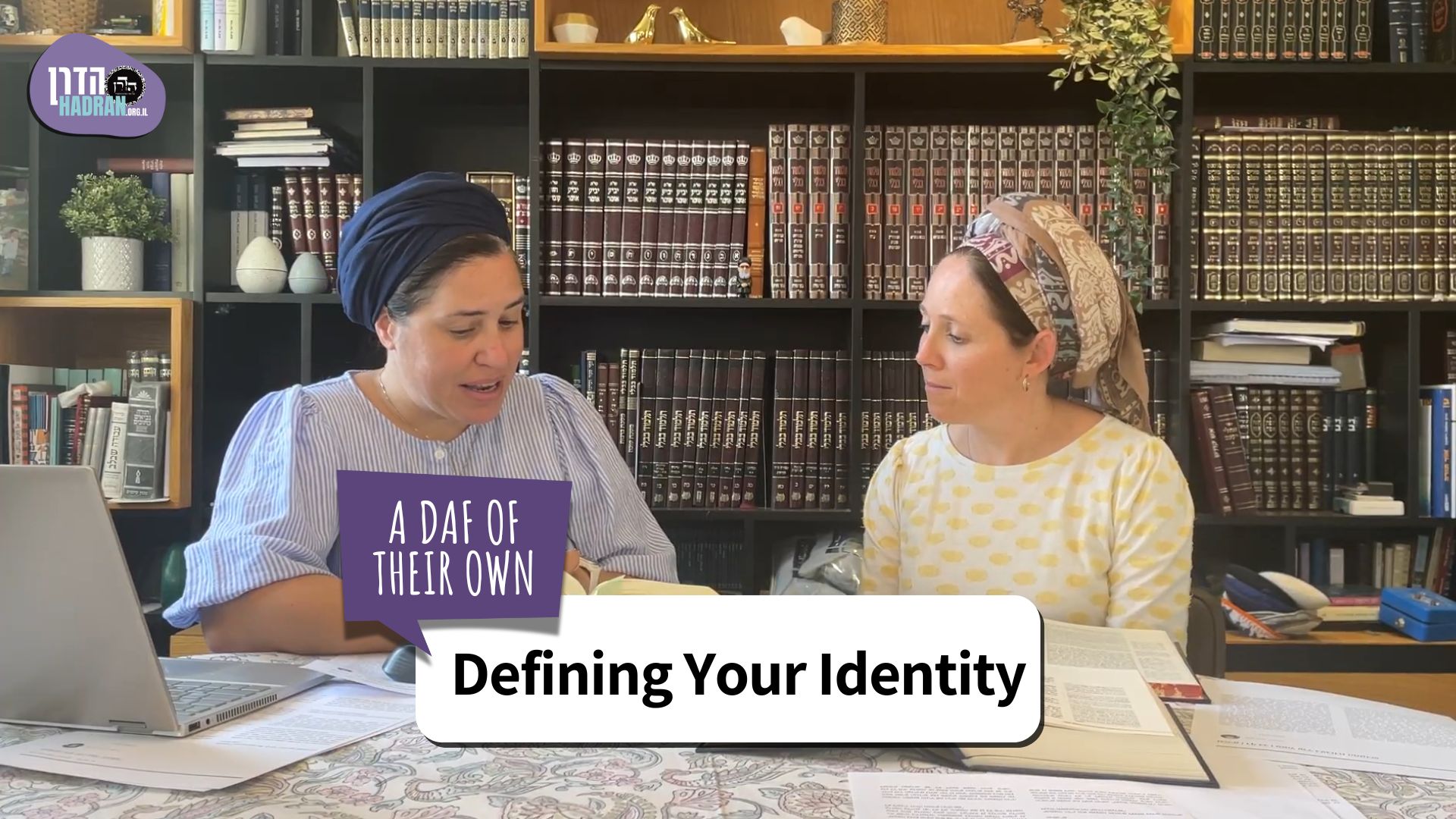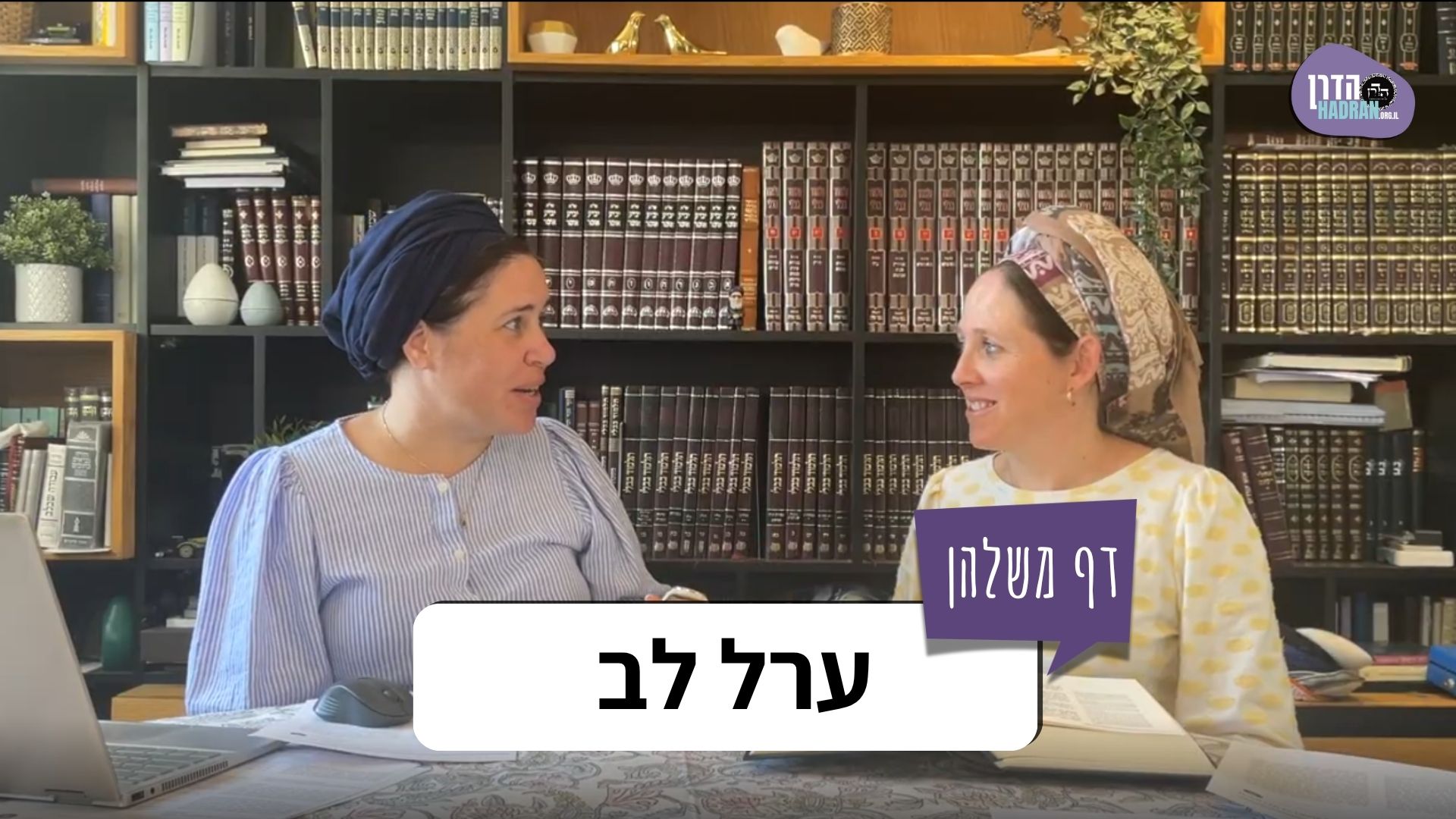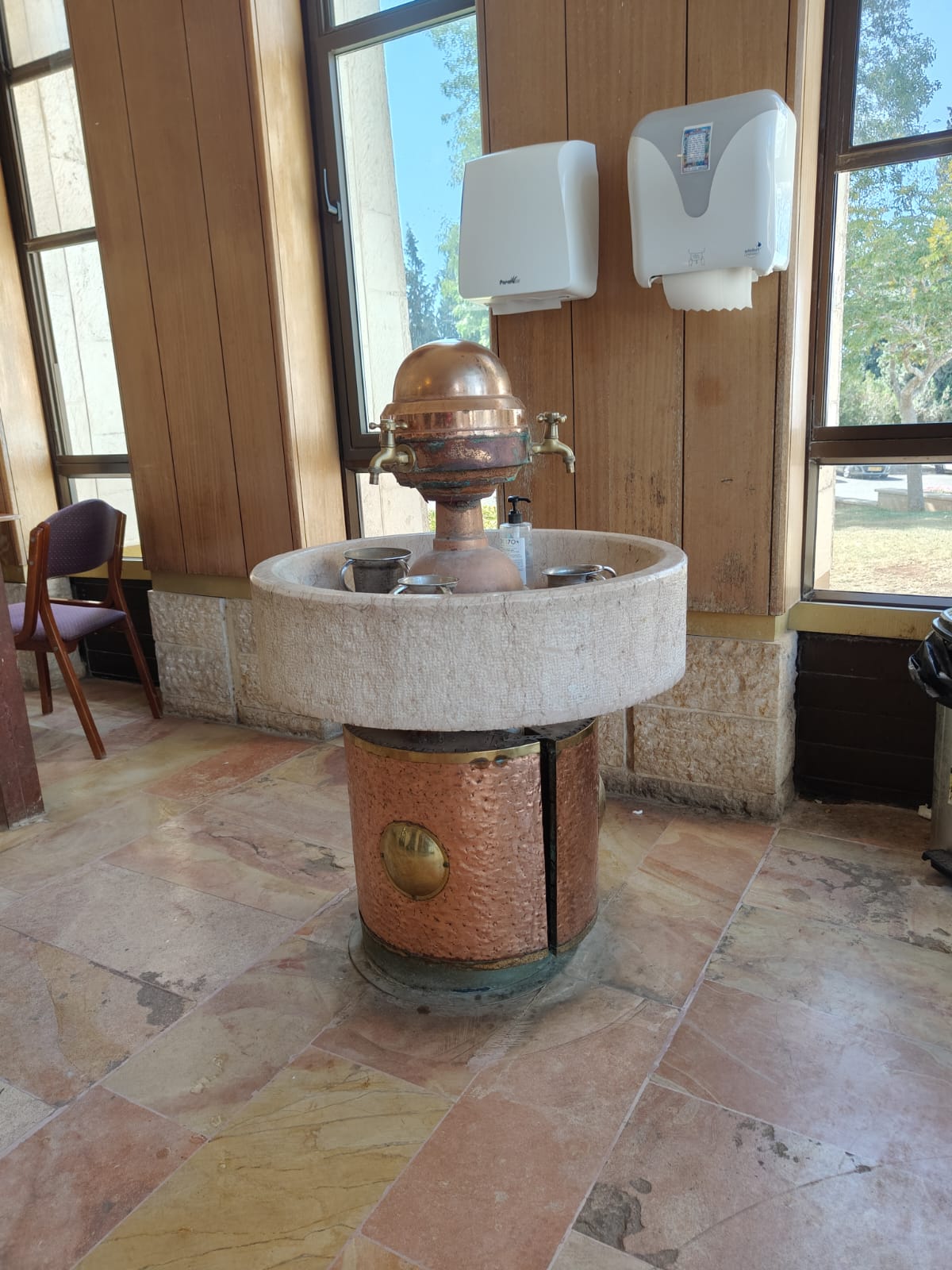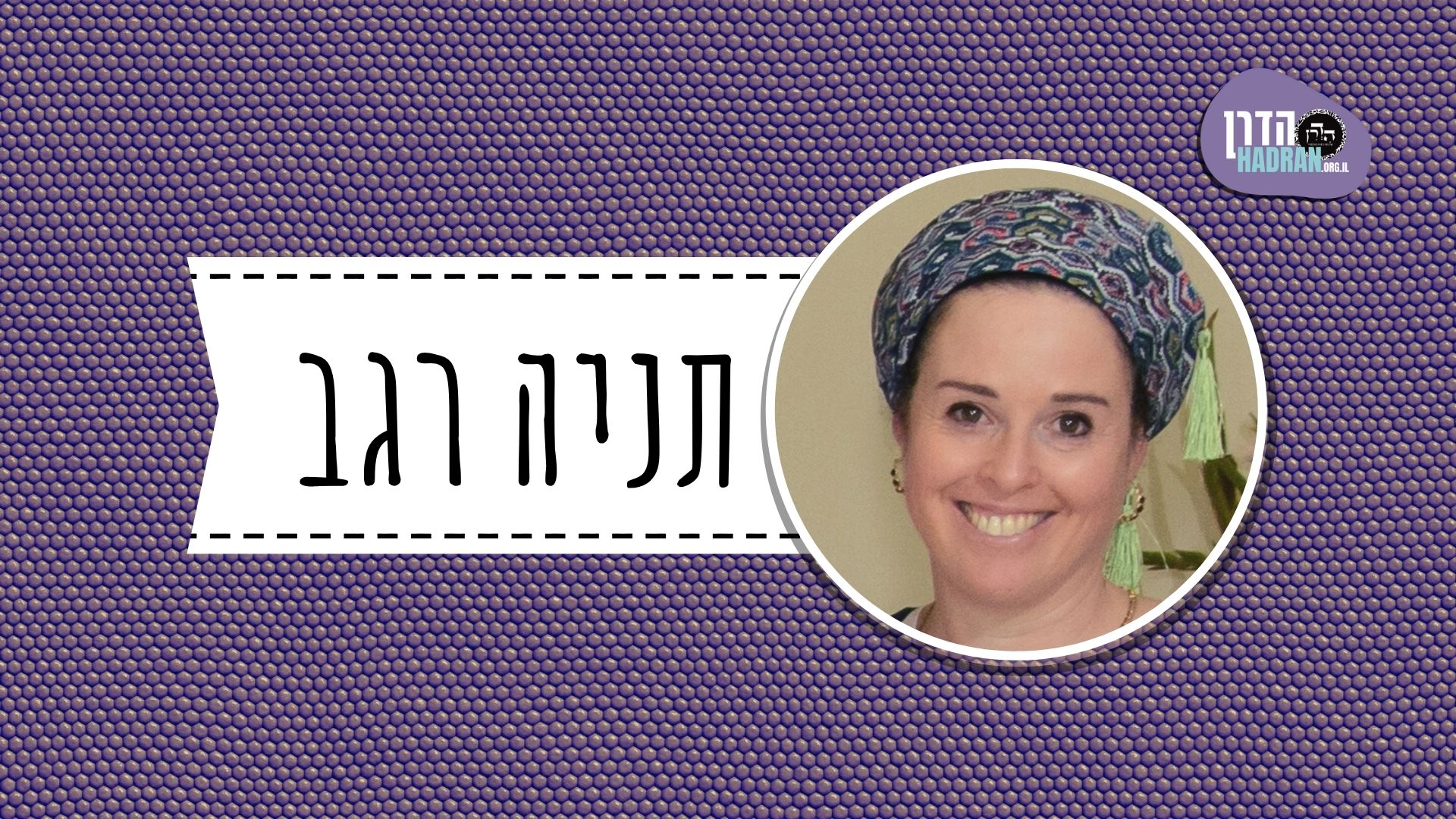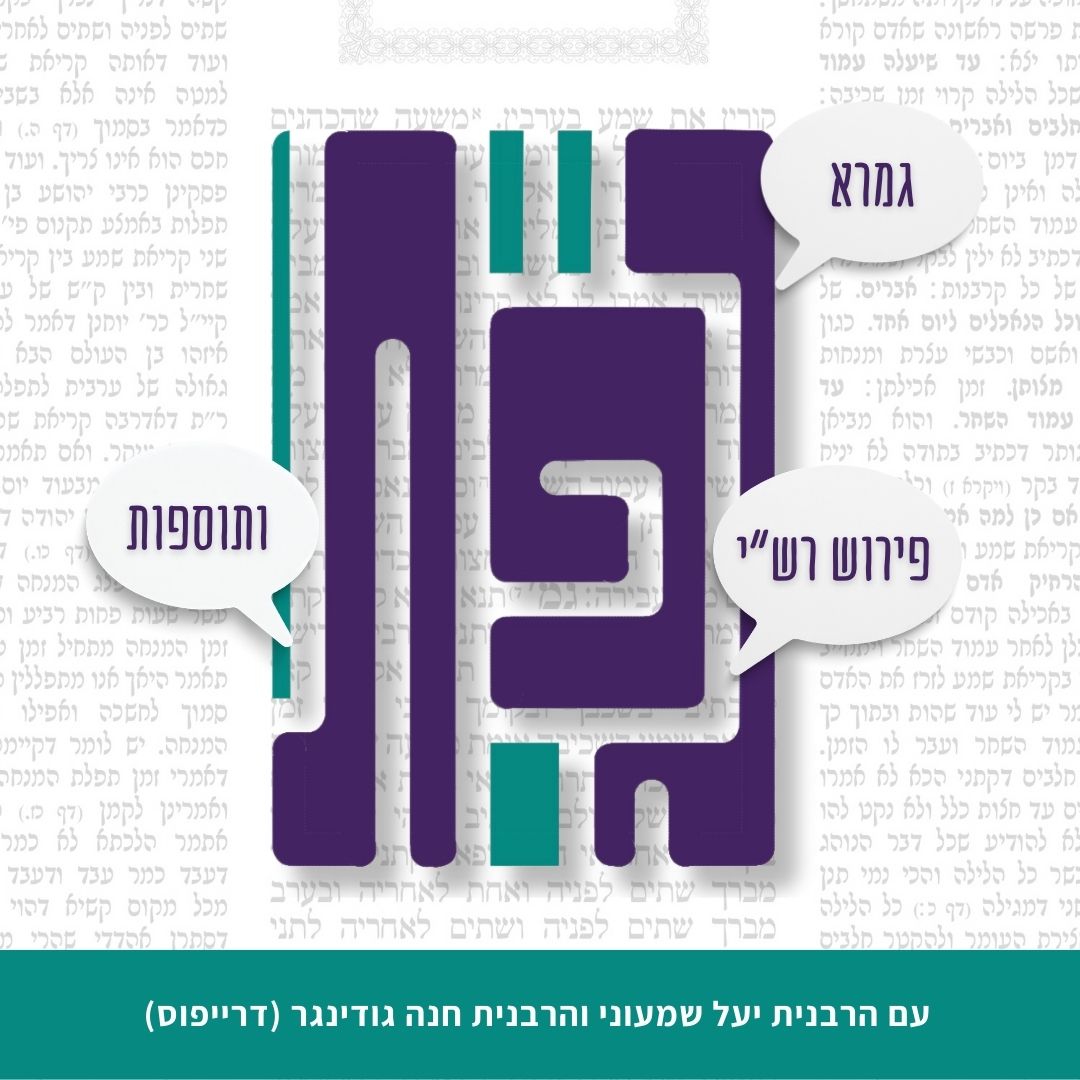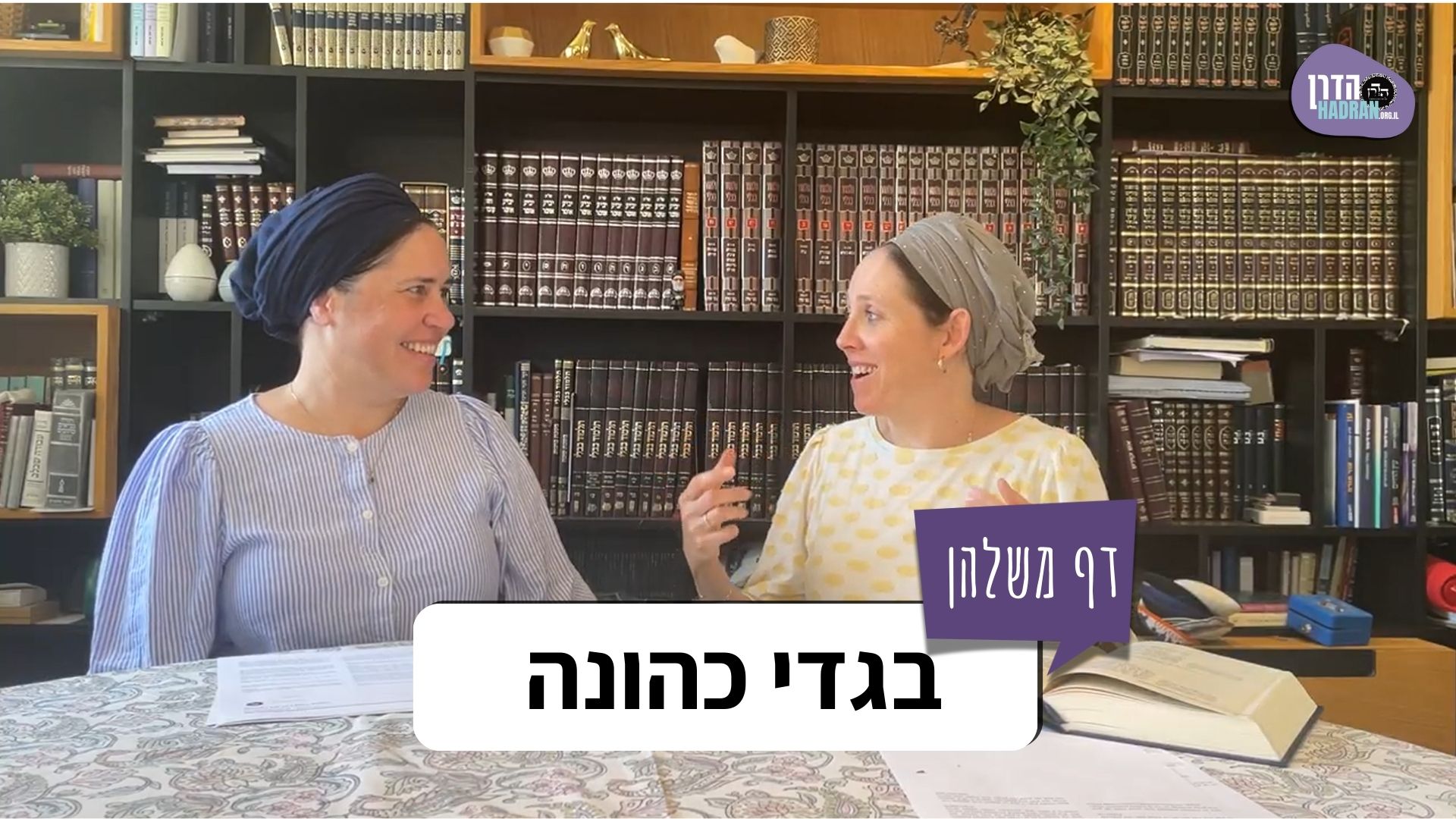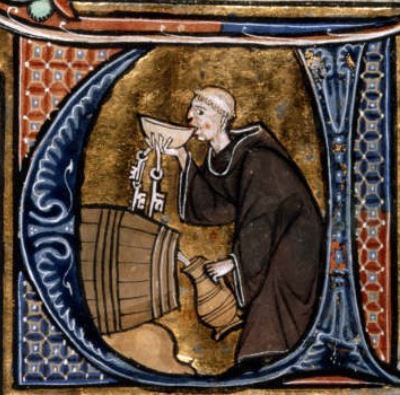This month’s learning is sponsored by Beth Balkany in honor of their granddaughter, Devorah Chana Serach Eichel. “May she grow up to be a lifelong learner.”
Masechet Zevachim
Masechet Zevachim is sponsored by Esther Kremer in loving memory of her father, Manny Gross on his third yahrzeit. “He exemplified a path of holiness and purity, living with kedushah in his everyday life.”
Want to dedicate learning? Get started here:


Summary
Seder Kodashim Kit – Bookmark Order Form
In the Torah verse regarding the purification of the leper (Vayikra 14:17), the word “right” appears three times – once in reference to the hand, once to the foot, and once to the ear. Rava explains that each mention teaches the requirement to use the right hand in a different ritual: one for kemitza (taking a handful of flour) in meal offerings, one for chalitza (the release ceremony of levirate marriage), and one for piercing the ear of a Jewish slave.
According to Rabba bar bar Hanna, quoting Rabbi Yochanan, wherever the Torah uses the term “kohen,” the action must be performed with the right hand. Based on this, Rava’s drasha regarding kemitza teaches that not only the taking of the kometz (handful) must be done with the right hand, but also its placement into the kli sharet (sanctified vessel).
Rabbi Shimon, who either does not require this part of the process or does not require it to be done with the right hand, agrees that the kemitza itself must be performed with the right hand, as derived from Vayikra 6:10, which compares the meal offering to the sin offering. Therefore, Rava’s interpretation applies specifically to the meal offering of a sinner, brought as part of a sliding scale offering.
The Mishna rules that if the blood spills directly onto the floor from the animal, without first being collected in a sanctified vessel, the blood is disqualified.
A braita teaches that the blood to be collected must be the spurting blood from the act of slaughter – not blood from a cut, nor residual blood that flows after most of the blood has exited the animal. The blood must flow directly from the animal into the kli sharet, from which it will be sprinkled on the altar. These laws are derived from Vayikra 4:5, in the context of the sin offering of the Kohen Gadol.
Rav rules that all of the blood must be collected, based on Vayikra 4:7. According to Shmuel, the knife must be lifted immediately after slaughter to prevent blood from dripping off the knife into the vessel, since the blood must come directly from the animal. Rav Chisda and Rabbi Yochanan explain that the animal’s throat must be held directly over the vessel to ensure the blood flows straight into it.
Rabbi Asi posed a question to Rabbi Yochanan regarding the airspace above a vessel. The Gemara brings three versions of the question and Rabbi Yochanan’s response:
- If the bottom of the vessel broke before the blood reached it, but the blood had already entered the vessel’s airspace, does this count as if the blood had reached the vessel? If so, the blood could be collected from the floor and used on the altar. To answer the question, Rabbi Yochanan cited a braita regarding a barrel into which fresh water streamed into its airspace, disqualifying it for use in the red heifer purification waters, as it is considered as though the water entered the vessel. However, this comparison is problematic, since the red heifer case does not involve a broken vessel. To justify the citation, the Gemara reframes the question as a two-pronged inquiry.
- The question was about the barrel, and the answer was drawn from the aforementioned braita.
- The question was about the barrel, and the answer was derived from the laws of sacrificial blood, which must reach the vessel directly. Since the blood passes through the airspace first, this implies that the airspace is treated as part of the vessel.
If the animal becomes blemished after slaughter but before the blood is collected, brought to the altar, or poured, the blood is disqualified. A source is cited from the laws of the sin offering to support this. The Gemara attempts to extend this ruling to offerings of lesser sanctity, such as the Paschal sacrifice, but the proof is ultimately rejected.
This month’s learning is sponsored by Beth Balkany in honor of their granddaughter, Devorah Chana Serach Eichel. “May she grow up to be a lifelong learner.”
Masechet Zevachim
Masechet Zevachim is sponsored by Esther Kremer in loving memory of her father, Manny Gross on his third yahrzeit. “He exemplified a path of holiness and purity, living with kedushah in his everyday life.”
Delve Deeper
Broaden your understanding of the topics on this daf with classes and podcasts from top women Talmud scholars.
New to Talmud?
Check out our resources designed to help you navigate a page of Talmud – and study at the pace, level and style that fits you.
The Hadran Women’s Tapestry
Meet the diverse women learning Gemara at Hadran and hear their stories.
Zevachim 25
וּלְרַבִּי שִׁמְעוֹן – דְּלָא בָּעֵי קִידּוּשׁ קוֹמֶץ; וּלְמַאן דְּאָמַר לְרַבִּי שִׁמְעוֹן נָמֵי בָּעֵי קִידּוּשׁ – קוֹמֶץ בִּשְׂמֹאל אַכְשׁוֹרֵי מַכְשַׁר; ״יָד״–״יָד״ דְּרָבָא לְמָה לִי?
The Gemara asks: And according to Rabbi Shimon, who does not require sanctification of the handful, or according to the one who says that Rabbi Shimon also requires the sanctification of the handful but that he deems the sanctification fit when performed with the left hand, why do I need the verbal analogy of Rava between “hand” and “hand”?
אִי לִקְמִיצָה עַצְמָהּ – מִדְּרַב יְהוּדָה בְּרֵיהּ דְּרַבִּי חִיָּיא נָפְקָא; דְּאָמַר רַב יְהוּדָה בְּרֵיהּ דְּרַבִּי חִיָּיא: מַאי טַעְמָא דְּרַבִּי שִׁמְעוֹן? דְּאָמַר קְרָא: ״קֹדֶשׁ קָדָשִׁים הִיא כַּחַטָּאת וְכָאָשָׁם״;
If one suggests that it is necessary to indicate that the removal of the handful itself must be performed with the right hand, this cannot be, since that is derived from the verse cited by Rav Yehuda, son of Rabbi Ḥiyya. As Rav Yehuda, son of Rabbi Ḥiyya, says: What is the reason that Rabbi Shimon does not require that the handful be sanctified in a service vessel? As the verse states with regard to the meal offering: “It is most holy, as the sin offering, and as the guilt offering” (Leviticus 6:10).
בָּא לְעוֹבְדָהּ בַּיָּד – עוֹבְדָהּ בְּיָמִין, כְּחַטָּאת; בָּא לְעוֹבְדָהּ בִּכְלִי – עוֹבְדָהּ בִּשְׂמֹאל, כְּאָשָׁם!
The verse compares the meal offering to a sin offering and a guilt offering. Therefore, if the priest comes to perform the burning of the handful with his hand, then he performs it with his right hand, like a sin offering, whose blood is sprinkled by hand. And if he comes to perform it with a vessel, i.e., if he first sanctifies the handful in a service vessel, then he may perform it with his left hand, like a guilt offering, whose blood is sprinkled from a vessel. Since the removal of the handful is performed by hand, the verse indicates that it must be performed with the right hand, and the verbal analogy is unnecessary.
לֹא נִצְרְכָא [אֶלָּא] לְקוֹמֵץ מִנְחַת חוֹטֵא; סָלְקָא דַּעְתָּךְ אָמֵינָא, הוֹאִיל וְאָמַר רַבִּי שִׁמְעוֹן שֶׁלֹּא יְהֵא קׇרְבָּנוֹ מְהוּדָּר – כִּי קָמַץ לַהּ בִּשְׂמֹאל נָמֵי תִּיתַּכְשַׁר; קָא מַשְׁמַע לַן.
The Gemara responds: The verbal analogy is necessary only for the handful of a meal offering of a sinner, to teach that it must be removed with the right hand. It might enter your mind to say: Since Rabbi Shimon says that this offering does not require oil and frankincense so that his offering will not be of superior quality, perhaps when he removed the handful with his left hand, which is an inferior manner, it should be fit as well. The verbal analogy therefore teaches us that the handful must always be removed with the right hand, even in the case of the meal offering of a sinner.
מַתְנִי׳ נִשְׁפַּךְ הַדָּם עַל הָרִצְפָּה, וַאֲסָפוֹ – פָּסוּל.
MISHNA: If the blood spilled on the floor before the priest managed to collect it into a vessel, and the priest then collected it from the floor into a vessel, it is disqualified.
גְּמָ׳ תָּנוּ רַבָּנַן: ״וְלָקַח הַכֹּהֵן הַמָּשִׁיחַ מִדַּם הַפָּר״ – מִדַּם הַנֶּפֶשׁ, וְלֹא מִדַּם הָעוֹר וְלֹא מִדַּם הַתַּמְצִית.
GEMARA: The Sages taught: The verse states: “And the anointed priest shall take from the blood of the bull [middam happar]” (Leviticus 4:5). This means that the priest shall take from the blood of the soul, i.e., the blood that flows from the place of slaughter as the animal dies, but not from the blood of the skin, which bleeds out when the skin is cut before the slaughter, nor from the blood of exudate, i.e., that exudes from the neck of the animal after the initial spurt of its slaughter concludes.
״מִדַּם הַפָּר״ – דָּם מֵהַפָּר יְקַבְּלֶנּוּ. דְּאִי סָלְקָא דַעְתָּךְ ״מִדַּם הַפָּר״ כְּדִכְתִיב – ״מִדַּם״ וַאֲפִילּוּ מִקְצָת דָּם; וְהָאָמַר רַב: הַשּׁוֹחֵט צָרִיךְ שֶׁיְּקַבֵּל אֶת כׇּל דָּמוֹ שֶׁל פַּר, שֶׁנֶּאֱמַר: ״וְאֵת כׇּל דָּמוֹ יִשְׁפֹּךְ״!
The baraita continues: When the verse states: “From the blood of the bull,” it should be interpreted as if it is written: He shall collect the blood from the bull, i.e., if the blood spills onto the floor before it is collected in a service vessel, it is disqualified. As, if it enters your mind that “from the blood of the bull” should be interpreted as it is written, i.e., that “from the blood” means that the priest may collect even only a portion of the blood, that is difficult: But doesn’t Rav say: One who slaughters the offering must collect all the blood of the bull, as it is stated: “And all the blood of the bull he shall pour out on the base of the altar” (Leviticus 4:7)? The verse emphasizes that the priest must pour all the blood of the bull, which is possible only if he has collected all of it.
אֶלָּא ״מִדַּם הַפָּר״ – דָּם מֵהַפָּר יְקַבְּלֶנּוּ. וְקָסָבַר: גּוֹרְעִין וּמוֹסִיפִין וְדוֹרְשִׁין.
Rather, “from the blood of the bull” means that the priest shall collect the blood from the bull. And this Sage holds that the Sages subtract and add and interpret homiletically, i.e., one may take a letter from one word, insert it into a second word, and explain the phrase in that manner. In this case, the mem of middam is added to happar, so that the verse is interpreted as though it states: Dam mehappar, meaning: Blood from the bull.
גּוּפָא – אָמַר רַב יְהוּדָה אָמַר רַב: הַשּׁוֹחֵט צָרִיךְ שֶׁיְּקַבֵּל אֶת כׇּל דָּמוֹ שֶׁל פַּר, שֶׁנֶּאֱמַר: ״וְאֵת כׇּל דַּם הַפָּר יִשְׁפֹּךְ״. וְהָא בְּשִׁירַיִים כְּתִיב!
§ The Gemara turns to the matter itself: Rav Yehuda says that Rav says: One who slaughters the offering must collect all the blood of the bull, as it is stated: “And all the blood of the bull he shall pour out on the base of the altar.” The Gemara asks: But isn’t this verse written with regard to the remainder of the blood that is poured onto the base of the altar after the sprinkling? How, then, can a halakha with regard to the collection of the blood be derived from it?
אִם אֵינוֹ עִנְיָן לְשִׁירַיִים – דְּהָא לֵיתֵיהּ לְכוּלֵּיהּ דָּם; תְּנֵיהוּ עִנְיָן (בְּקַבָּלָה) [לְקַבָּלָה].
The Gemara responds: If this verse is not referring to the matter of the remainder of the blood after sprinkling, as not all of the blood is present for that rite since some of it has already been sprinkled, apply it instead to the matter of collection of the blood from the animal.
אָמַר רַב יְהוּדָה אָמַר שְׁמוּאֵל: הַשּׁוֹחֵט צָרִיךְ שֶׁיַּגְבִּיהַּ סַכִּין לְמַעְלָה, שֶׁנֶּאֱמַר: ״וְלָקַח מִדַּם הַפָּר״ – וְלֹא מִדַּם הַפָּר וְדָבָר אַחֵר.
Rav Yehuda says that Shmuel says: One who slaughters the offering must hold the knife up after slaughter, so that blood that is on the knife does not fall into the service vessel, as it is stated: “And the anointed priest shall take from the blood of the bull,” i.e., and not from a mixture of the blood of the bull and something else, such as the blood from the knife.
וְדַם סַכִּין בְּמַאי מְקַנַּח לֵיהּ? אָמַר אַבָּיֵי: בִּשְׂפַת מִזְרָק, כְּדִכְתִיב: ״כְּפוֹרֵי זָהָב״.
The Gemara asks: And with what does he wipe the blood from the knife? Abaye says: He wipes it with the rim of the bowl used to collect the blood, as it is written of the bowls used to collect the blood: “Atoning-bowls [keforei] of gold” (Ezra 1:10). The root kaf, peh, reish can also mean to wipe.
אָמַר רַב חִסְדָּא אָמַר רַב יִרְמְיָה בַּר אַבָּא: הַשּׁוֹחֵט צָרִיךְ שֶׁיִּתֵּן
Rav Ḥisda says that Rav Yirmeya bar Abba says: One who slaughters the offering must place
וְרִידִין לְתוֹךְ הַכְּלִי. אִיתְּמַר נָמֵי, אָמַר רַב אַסִּי אָמַר רַבִּי יוֹחָנָן: וְרִידִין צָרִיךְ שֶׁיִּרְאוּ אֲוִיר כְּלִי.
the veins of the offering into the vessel, so that all the blood will empty into it. It was also stated: Rav Asi says that Rabbi Yoḥanan says: The veins must see the airspace of the vessel.
בְּעָא מִינֵּיהּ רַבִּי אַסִּי מֵרַבִּי יוֹחָנָן: הָיָה מְקַבֵּל, וְנִפְחֲתוּ שׁוּלֵי מִזְרָק עַד שֶׁלֹּא הִגִּיעַ דָּם לַאֲוִיר – מַהוּ? אֲוִיר שֶׁאֵין סוֹפוֹ לָנוּחַ – כְּמוּנָּח דָּמֵי, אוֹ לָא כְּמוּנָּח דָּמֵי?
§ Rabbi Asi raised a dilemma before Rabbi Yoḥanan: If the priest was collecting the blood, and the bottom of the bowl broke before the blood reached the bowl’s airspace, what is the halakha? Is blood that enters the airspace of a bowl that will not ultimately allow it to settle inside nevertheless considered as though it settled inside the vessel, so that when it spills through the break it is considered to have already been collected in the bowl? If so, it remains fit for sprinkling. Or is it not considered as though it settled, but is instead considered to have spilled directly from the animal’s neck onto the floor, and is therefore disqualified?
אֲמַר לֵיהּ, תְּנֵיתוּהָ: חָבִית שֶׁמּוּנַּחַת תַּחַת הַזִּינּוּק – מַיִם שֶׁבְּתוֹכָהּ וְשֶׁבְּחוּצָה לַהּ, פְּסוּלִין. צֵירַף פִּיהָ לַזִּינּוּק – מַיִם שֶׁבְּתוֹכָהּ פְּסוּלִין, וְשֶׁבְּחוּצָה לָהּ כְּשֵׁירִין.
Rabbi Yoḥanan said to him: You learned the answer in a baraita: With regard to a barrel that is placed under a pipe to catch water running from it, both the water that has already flowed inside the barrel and that which is still outside it but about to fall in are unfit to be used as water of purification, which purify one who contracts impurity from a corpse. The water of purification must be flowing water, and all of this water is considered to have been collected in the barrel. But if one joined the mouth of the barrel to the pipe, the water that is inside the barrel is unfit, but water that is still outside it is fit, even though it will ultimately fall in, since it is still in the pipe and is not considered to be above the airspace of the barrel. One can infer from the baraita that all liquid that enters the airspace of a vessel is considered to have been collected in it.
הַאי מַאי בָּעֵי מִינֵּיהּ – אֲוִיר שֶׁאֵין סוֹפוֹ לָנוּחַ; וְקָא פָשֵׁט לֵיהּ אֲוִיר שֶׁסּוֹפוֹ לָנוּחַ!
The Gemara rejects this: What is this comparison? Rabbi Asi raises a dilemma before Rabbi Yoḥanan with regard to a case where an item enters the airspace of a vessel that will not ultimately allow it to settle inside, and Rabbi Yoḥanan resolves the dilemma by citing a case where the item enters the airspace of a vessel that will ultimately allow it to settle inside.
תַּרְתֵּי קָא בָעֵי מִינֵּיהּ; אִם תִּימְצֵי לוֹמַר: אֲוִיר שֶׁאֵין סוֹפוֹ לָנוּחַ – לָאו כְּמוּנָּח דָּמֵי, אֲוִיר שֶׁסּוֹפוֹ לָנוּחַ מַאי?
The Gemara responds: Rabbi Asi raises two dilemmas before Rabbi Yoḥanan: First, what is the halakha with regard to an item that will not come to rest in the vessel? Second, if you say that an item that enters the airspace of a vessel that will not ultimately allow it to settle inside is not considered as though it settled inside the vessel, what is the halakha with regard to an item that entered the airspace of a vessel that will ultimately allow it to settle inside?
רַב יוֹסֵף מַתְנֵי הָכִי. רַב כָּהֲנָא מַתְנֵי: חָבִית בְּעָא מִינֵּיהּ, וּפְשַׁט לֵיהּ חָבִית.
The Gemara notes: Rav Yosef teaches the exchange in this manner, i.e., as recounted. Rav Kahana teaches it as follows: Rabbi Asi raised the dilemma before Rabbi Yoḥanan with regard to a barrel, asking whether the water in its airspace is fit to be used for the water of purification, and Rabbi Yoḥanan resolved the dilemma for him by citing the baraita mentioning a barrel, with which he was unfamiliar.
רַבָּה מַתְנֵי: חָבִית בְּעָא מִינֵּיהּ, וּפְשַׁט לֵיהּ מִזְרָק – אִי אַתָּה מוֹדֶה בְּמִזְרָק, שֶׁאִי אִיפְשָׁר לוֹ בְּלֹא זִינּוּק?!
Rabba teaches the exchange as follows: Rabbi Asi raised the dilemma before Rabbi Yoḥanan with regard to a barrel, and Rabbi Yoḥanan resolved the dilemma for him by citing the halakha concerning a bowl used to collect the blood in the Temple, saying: Do you not concede with regard to the bowl that it is impossible to collect the blood in it without a stream of blood flowing through the air from the animal’s neck? If the air above the bowl is not considered part of the bowl, the blood would be considered to have entered the bowl from the air above rather than directly from the animal’s neck, and all collected blood would be unfit. Therefore, the airspace must be considered part of the bowl, and the same holds for the barrel with regard to the water of purification.
תְּנַן הָתָם: נָתַן יָדוֹ אוֹ רַגְלוֹ אוֹ עֲלֵי יְרָקוֹת כְּדֵי שֶׁיַּעַבְרוּ מַיִם לֶחָבִית – פְּסוּלִין. עֲלֵי קָנִים וַעֲלֵי אֱגוֹזִים – כְּשֵׁירָה. זֶה הַכְּלָל: דָּבָר הַמְקַבֵּל טוּמְאָה – פְּסוּלִין, דָּבָר שֶׁאֵינוֹ מְקַבֵּל טוּמְאָה – כְּשֵׁירִין.
The Gemara adds: We learned in a mishna elsewhere (Para 6:4) with regard to sanctifying the water of purification: If one placed his hand or his foot or vegetable leaves in order to allow flowing water to pass through them to the barrel, the water is disqualified. But if the water passed through leaves of reeds or leaves of nuts, the water remains fit. This is the principle: If the water passes through an item that is susceptible to impurity, it is disqualified; if it passes through an item that is not susceptible to impurity, it is fit.
מְנָא הָנֵי מִילֵּי? דְּאָמַר רַבִּי יוֹחָנָן מִשּׁוּם רַבִּי יוֹסֵי בַּר אַבָּא, אָמַר קְרָא: ״אַךְ מַעְיָן וּבוֹר מִקְוֵה מַיִם יִהְיֶה טָהוֹר״ – הֲוָיָיתָן עַל יְדֵי טׇהֳרָה תְּהֵא.
The Gemara asks: From where are these matters derived? As Rabbi Yoḥanan says in the name of Rabbi Yosei bar Abba: The verse states: “Nevertheless a fountain or a cistern wherein is a gathering of water shall be pure” (Leviticus 11:36). The verse indicates that their being must be by way of purity, i.e., the gathering of the water must not be accomplished by way of items susceptible to impurity.
אָמַר רַבִּי חִיָּיא אָמַר רַבִּי יוֹחָנָן: זֹאת אוֹמֶרֶת, אֲוִיר כְּלִי כִּכְלִי דָּמֵי.
Rabbi Ḥiyya says that Rabbi Yoḥanan says: Since this mishna states that water that flows over one’s hand through the air into the barrel is disqualified, that is to say that the airspace above a vessel is considered as though it were part of the vessel itself. If it were not, the water would not be considered to have flowed directly from the hand to the vessel, but rather from the air above the vessel. Since air is not susceptible to impurity, the water would not be disqualified.
אֲמַר לֵיהּ רַבִּי זֵירָא לְרַבִּי חִיָּיא בַּר אַבָּא: וְדִילְמָא בְּשׁוֹתֵת? אֲמַר לֵיהּ: תְּרָדָא! ״כְּדֵי שֶׁיַּעַבְרוּ מַיִם לֶחָבִית״ תְּנַן!
Rabbi Zeira said to Rabbi Ḥiyya bar Abba: But perhaps the mishna is referring to a case where the water flows weakly straight from the hand into the vessel itself, since the hand is situated directly on the edge of the vessel, with no air separating them? Rabbi Ḥiyya bar Abba said to him: Imbecile, we learned in the mishna: In order to allow flowing water to pass through them to the barrel. This indicates that the water is traveling in a stream and will pass through the air before reaching the barrel.
וְאָמַר רַבִּי חִיָּיא בַּר אַבָּא אָמַר רַבִּי יוֹחָנָן: מֵעֵדוּתוֹ שֶׁל רַבִּי צָדוֹק נִישְׁנֵית מִשְׁנָה זוֹ; דִּתְנַן: הֵעִיד רַבִּי צָדוֹק עַל הַזּוֹחֲלִין שֶׁקִּילְּחָן בַּעֲלֵי אֱגוֹזִין – שֶׁהֵן כְּשֵׁירִין; זֶה הָיָה מַעֲשֶׂה בְּאוֹהָלִיָּיא, וּבָא מַעֲשֶׂה לִפְנֵי חֲכָמִים בְּלִשְׁכַּת הַגָּזִית, וְהִכְשִׁירוּ.
And Rabbi Ḥiyya bar Abba says that Rabbi Yoḥanan says: This mishna concerning the barrel was taught from the testimony of Rabbi Tzadok, as we learned in a mishna (Eduyyot 7:4): Rabbi Tzadok testified with regard to rivulets that one diverted by way of a pipe made with leaves of nuts that their water is fit to be used as water of purification. This was an incident in the town of Ohalya, and an account of the incident came before the Sages in the Chamber of Hewn Stone in the Temple, and they deemed the water fit.
אָמַר רַבִּי זֵירָא אָמַר רַבִּי: הַצּוֹרֵם אֹזֶן הַפָּר, וְאַחַר כָּךְ קִיבֵּל דָּמוֹ – פָּסוּל; שֶׁנֶּאֱמַר: ״וְלָקַח מִדַּם הַפָּר״ – פַּר שֶׁהָיָה כְּבָר.
§ Rabbi Zeira says that Rabbi Yehuda HaNasi says: In the case of one who slits the ear of the bull with the knife after slaughter, creating a blemish, and thereafter collected its blood from the neck, the offering is disqualified, as it is stated: “And the anointed priest shall take from the blood of the bull” (Leviticus 4:5). By referring to the animal as a bull even after its slaughter, the verse indicates that the bull must be at the time of collection of the blood as it already was before slaughter, without a blemish.
אַשְׁכְּחַן קׇדְשֵׁי קֳדָשִׁים; קָדָשִׁים קַלִּים מְנָלַן?
The Gemara asks: We found a source for this halakha with regard to offerings of the most sacred order, since the verse is referring to such an offering; from where do we derive that the same holds for offerings of lesser sanctity?
אָמַר רָבָא, תַּנְיָא: ״שֶׂה תָמִים זָכָר בֶּן שָׁנָה״ – שֶׁיְּהֵא תָּמִים וּבֶן שָׁנָה בִּשְׁעַת שְׁחִיטָה. בְּקַבָּלָה, בְּהוֹלָכָה, בִּזְרִיקָה – מִנַּיִן? תַּלְמוּד לוֹמַר: ״יִהְיֶה״ – כׇּל הֲוָייוֹתָיו לֹא יִהְיוּ אֶלָּא תָּם וּבֶן שָׁנָה.
Rava says: It is taught in a baraita with regard to the Paschal offering, an offering of lesser sanctity: The verse states: “A lamb without blemish, a male of the first year it shall be for you” (Exodus 12:5), indicating that it shall be unblemished and in its first year at the time of slaughter. From where is it derived that it must also be without blemish at the time of collection of the blood, at the time of conveying the blood to the altar, and at the time of the sprinkling of the blood? The verse states: “It shall be,” emphasizing that all its happenings shall be only when it is unblemished and in its first year.
אֵיתִיבֵיהּ אַבָּיֵי, רַבִּי יְהוֹשֻׁעַ אוֹמֵר: כׇּל הַזְּבָחִים שֶׁבַּתּוֹרָה שֶׁנִּשְׁתַּיֵּיר מֵהֶן כְּזַיִת בָּשָׂר אוֹ כְּזַיִת חֵלֶב – זוֹרֵק אֶת הַדָּם!
Abaye raised an objection to this from a baraita: Rabbi Yehoshua says: With regard to any of the types of offerings that are mentioned in the Torah from which there remains either an olive-bulk of flesh or an olive-bulk of fat, the halakha is that the priest sprinkles the blood of that offering. Apparently, one may sprinkle the blood even if much of the offering is damaged or missing.
תַּרְגּוּמָא אַבֶּן שָׁנָה.
The Gemara responds: Interpret the verse as referring only to the requirement that the animal be in its first year until after the sprinkling. It may have a blemish at the time of sprinkling.
וּמִי אִיכָּא מִידֵּי דְּבִשְׁעַת שְׁחִיטָה בֶּן שָׁנָה, בִּשְׁעַת הוֹלָכָה וּזְרִיקָה בֶּן שְׁתֵּים?!
The Gemara challenges this: But is there any case where the animal is in its first year at the time of slaughter, but at the time of conveying the blood to the altar and sprinkling the blood it is in its second year?
אָמַר רָבָא: זֹאת אוֹמֶרֶת, שָׁעוֹת פּוֹסְלוֹת בַּקֳּדָשִׁים.
Rava says: That is to say that hours disqualify sacrificial animals, i.e., one measures the age of the offering from the exact time of its birth. It is therefore possible that the animal reaches its second year between its slaughter and the conveying of its blood to the altar.
אָמַר רַבִּי אַמֵּי אָמַר רַבִּי אֶלְעָזָר: הִיא בִּפְנִים וְרַגְלֶיהָ בַּחוּץ; חָתַךְ וְאַחַר כָּךְ שָׁחַט – כְּשֵׁירָה,
§ Rabbi Ami says that Rabbi Elazar says: In a case where the animal is standing inside the Temple courtyard but its legs are planted outside it, if one severed its legs and thereafter slaughtered it, the offering is fit, since all the blood collected in the bowl is from the portion of the animal standing in the courtyard.



